
















































Ever see a commercial harbor full of Furuno Marine Electronics and wonder why the pros rely on us?





See why here









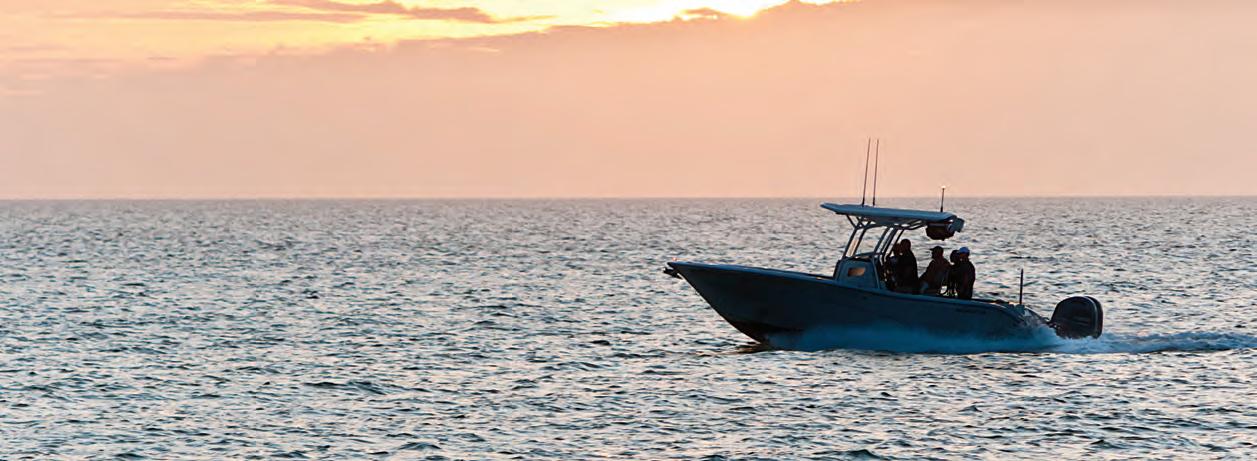
Are you ready to embark on your next on-water adventure? Before you set sail, here are fve things to know about boat insurance.
1. Boat insurance isn’t just for accidents
With comprehensive coverage, you’ll also be protected fnancially for theft, vandalism, and unexpected events like storms if you need repairs or replacements due to damage.
2. Accidents can happen to anyone
When accidents happen, boat insurance offers liability coverage for damages or injuries you cause while boating, up to specifed limits. It can also cover lawsuit costs if you’re sued.
3. Boat insurance can cover medical payments
Boat insurance offers a range of optional medical payments coverage limits, helping to cover medical expenses if you’re in an accident or someone is hurt on your boat, regardless of fault.
4. Most lenders require boat insurance
If you fnanced your boat, you’ll likely need boat insurance since most lenders require boat insurance to protect their investment. Additionally, some marinas or municipalities require proof of insurance for docking.
5. Progressive offers specialized boat coverages
Ever worry about getting stuck on the water?
Progressive’s Sign & Glide® On-Water Towing coverage** can help. It’s an additional coverage that steps in if your boat is disabled or breaks down on the water, paying for on-water towing, jump starts, soft ungroundings, and fuel delivery. Fuel cost isn’t included.
Don’t let unforeseen circumstances disrupt your voyage. Cruise with confdence thanks to Progressive Boat insurance. Because when it comes to your boat, peace of mind is the ultimate luxury.
Scan to get a quote in as little as 4 minutes.
to learn more.




















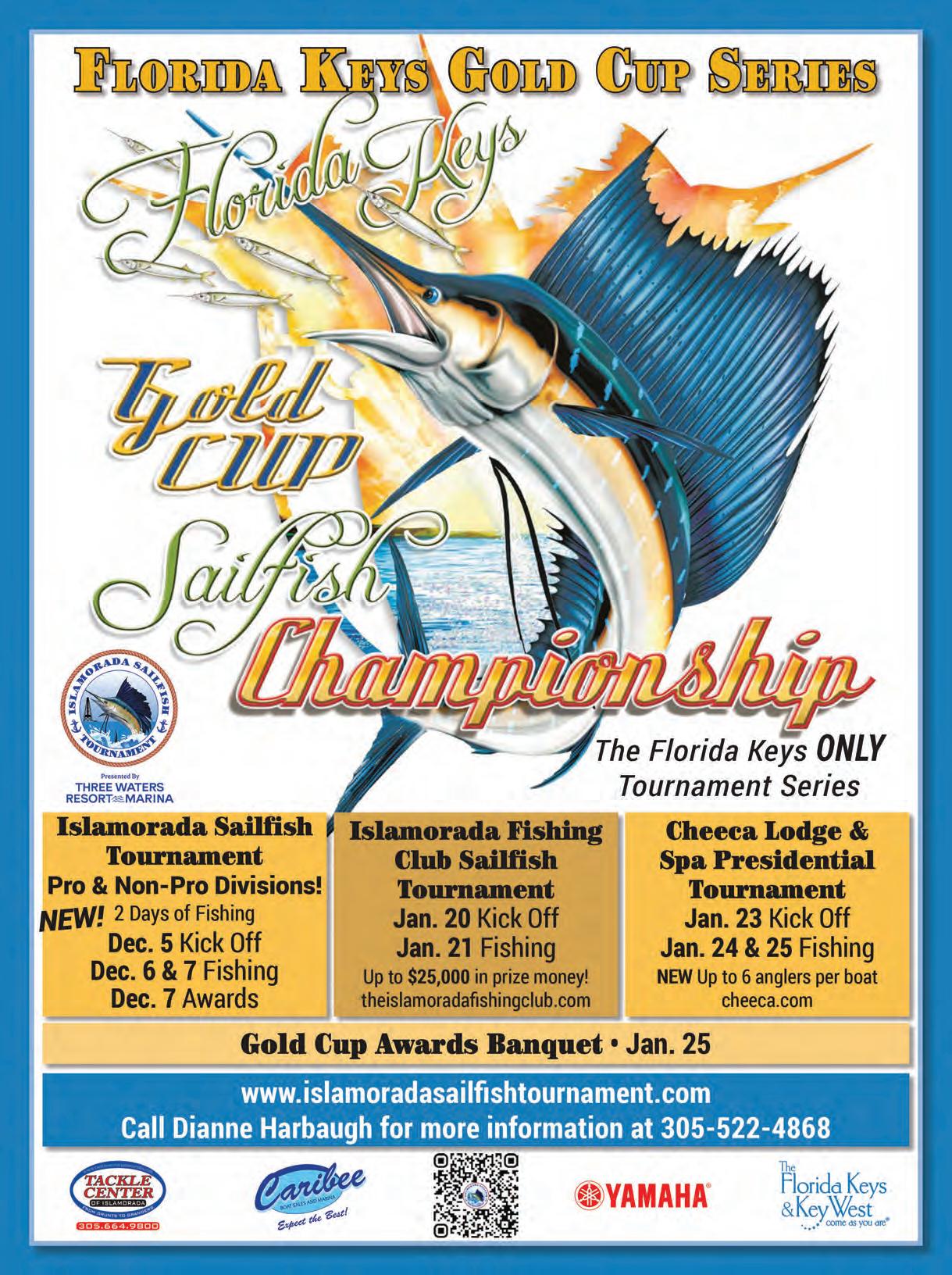


There’s remote, and then there’s Pulley Ridge. Sitting over 100 miles o! the coast of Florida, this underwater plateau is where the Gulf of Mexico drops into the deep blue, and it’s earned a legendary reputation as one of the most productive, and challenging, shing destinations in the U.S.


By Astrid deGruchy
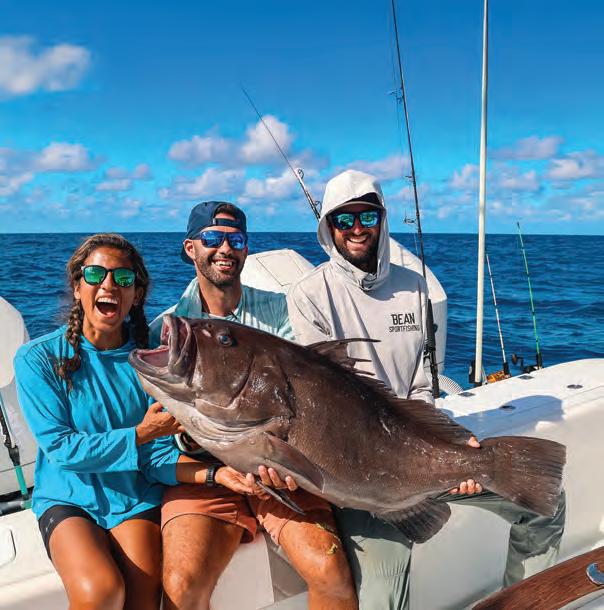

If you’re heading out there, you’ll need a serious o!shore machine. ink a 47’ Freeman or a Viking, something that can handle the long run and unpredictable Gulf conditions. is isn’t a trip for small center consoles or light tackle. Last time we were out there, we loaded up with PENN Fathom electrics paired with PENN Ally Electric rods & PENN International 50 VISX ready to drop into depths that test both your gear and your patience.
Using chicken rigs, we hauled in vermillion and yellow snappers in over 500 . of water that lled the box, but Pulley Ridge has a wild side where giant groupers and the occasional “what-the-heck-is-that” monsters lurk in the dark.


Pulley Ridge isn’t just another shing trip, it’s a rite of passage. e distance, the depth, the unknown, it all adds up to one of those bucket-list adventures every angler should do once in their life, especially with a crew of buddies who live for the chase. While you’re out there, you can even make a stop at the Dry Tortugas, another incredible o!shore destination rich in history and beauty.
Check out the full Pulley Ridge expedition on YouTube, only on Bean Sport shing TV.







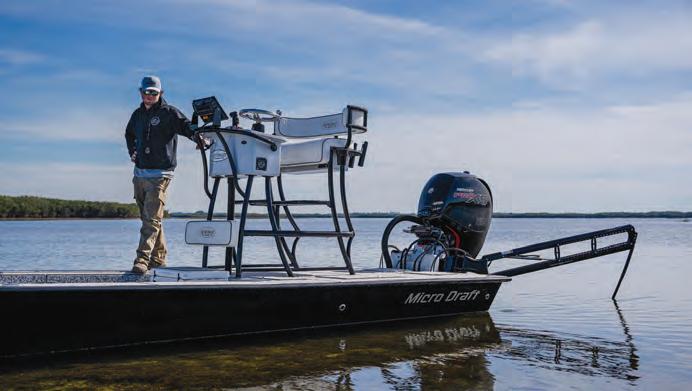





By Julie Graham

The Cherokee National Forest o!ers some of the best freestone trout shing in the Southeast. Spanning 650,000 acres across the Southern Appalachians, it’s the largest block of public land in Tennessee and it’s divided neatly in two by the Great Smoky Mountains National Park.
On the north side, mountain streams tumble through hemlock hollows toward Cosby. To the south, the waters of Citico Creek cut deep through wilderness ridges near the Unicoi Mountains. Together, they showcase the Cherokee’s range. From roadside creeks to backcountry runs, the forest o!ers anglers a taste of freestone Tennessee trout water.
Below the Great Smoky Mountains National Park boundary, Cosby Creek winds through the community of Cosby, Tennessee, o!ering accessible trout
water without the added park permit. ese lower stretches are regularly stocked by the Tennessee Wildlife Resources Agency (TWRA) and can provide productive shing throughout spring and fall. While access is somewhat limited, anglers will nd several bridges and pull-o!s along Highway 32 where they can wade in. e streambed is rocky and slick, with plenty of boulder pockets and undercut banks—good traction and careful footing are essential. Expect stocked rainbows with the occasional brown trout.
Inside the Park, the Cosby Campground section is ideal for bank shing and light wading, especially for those who prefer easy access close to trails and picnic areas. Brook trout dominate the upper reaches, while rainbows hold in the deeper pools below.
To the south, Citico Creek drains more than 20,000 acres of rugged country on the western edge of the Cherokee. Fed by the north and south forks rising in the Unicoi Mountains, Citico o!ers a blend of stocked and wild trout water—ideal for anglers who like a mix of easy access and adventure.
e TWRA regularly stocks Citico from Little Citico Creek to the Citico Creek Wilderness boundary, while the upper forks hold self-sustaining populations of wild rainbows and browns.
e Cherohala Skyway marks the southern edge of the Citico Creek watershed, and just driving it is worth the trip—sweeping vistas, ery fall colors, and the sound of water around every bend.
Autumn is prime time on both sides of the Cherokee National Forest. Water temperatures drop, trout feed hard before winter, and the hardwood ridges turn to ame.
• Match the Hatch: Early fall favors terrestrials; in November, go small with blue-winged olives, midges, and caddis emergers.
• Go Light: Clear, low ows call for 6X or 7X tippet and longer casts.
• Mind the Leaves: Dri leaves can snag a line—look for deeper pools below ri&es where trout hold under cover.
• Start Late: Cooler nights mean shing o en improves mid-morning as the water warms slightly.
For more information, including licensing regulations, visit the Tennessee Wildlife Resources Agency at https://www.tn.gov/twra.html.


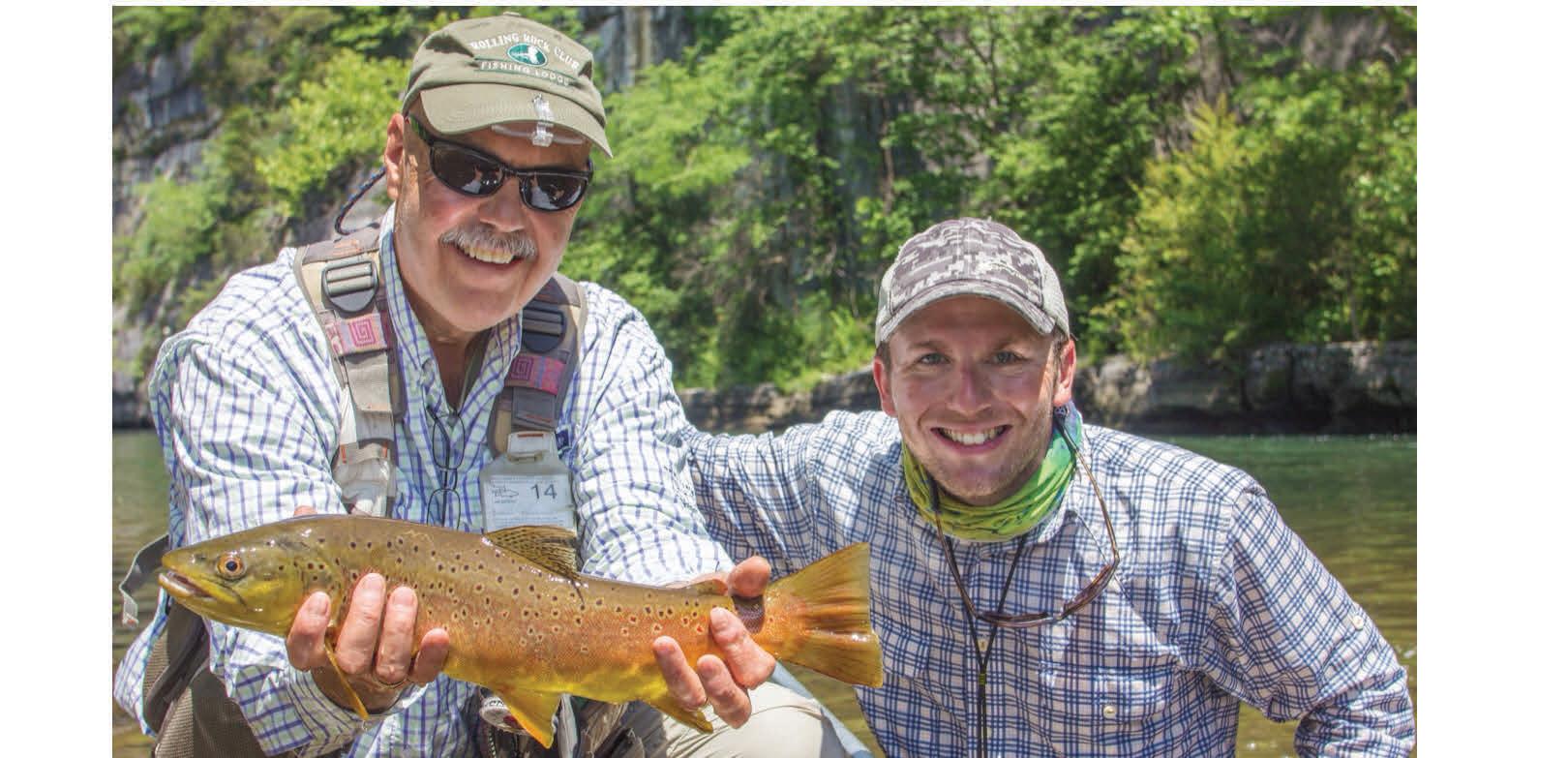








































































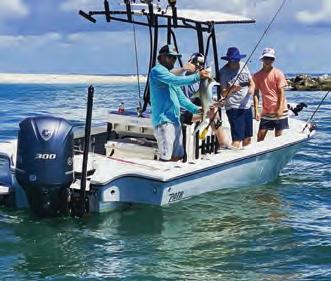






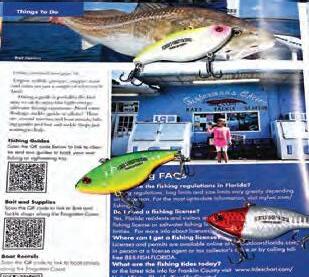












By Capt. Michael Okruhlik
There’s just something magical about fall shing. e air cools, the bait thins out, and everything that swims gets a little hungrier. For me, it’s the holy trinity of the season— ounder migrations, trout and reds chasing shrimp under screaming gulls, and the early whispers of trophy trout time.
The Fall Flounder Run
Ah, yes, the famous fall ounder migration. is is more prevalent in some areas, but they can be caught all along the Gulf Coast. ese at ambushers stack up near the passes as they make their way to spawn in the
Gulf, gorging on bait along the way. When I’m targeting ounder, I switch things up. My go-to is a scented so plastic, preferably the Titan Series from Knockin Tail Lures. Not only are they scented, but they also have a rattling tail. Working this along the bottom will entice violent strikes. Since ounder love to bury themselves and wait in ambush, I keep that lure tapping bottom, twitching my rod sideways, whether I’m wading or boating. It’s a nesse game—part patience, part persistence—and when that telltale “thump” hits, it’s pure satisfaction.
Birds, Bait, and Mayhem
en there’s the chaos of gulls dive-bombing over shrimp and schooling sh—a sight that’ll make any angler’s pulse jump. Fall o en brings bigger trout into the mix, turning every cast into a thrill. I prefer to use a heavier jighead (1/4 to 3/8 ounce) to achieve the desired action without spooking the birds or the sh. Durable so plastics help keep me in the ght longer, and I mash the barbs down for quick releases and faster re-casts. When the schools settle and the birds thin out, a topwater lure can coax the bruisers to rise— and few things beat watching a big trout explode on the surface.
As fall rolls on, my focus shi s toward trophy trout—and timing becomes everything. I’ve followed solunar shing tables since childhood, back when my grandparents’ calendars marked “good” and “poor” shing days with little sh icons. Over the years, I’ve been both a believer and a skeptic, but I’ve noticed a pattern: my best bites o en align with solunar peaks. Now, I plan my day around them. Instead of running and gunning, I’ll anchor in a promising area during a predicted feeding window and wait it out.
On a recent trip with my boys, we missed the morning bite but stuck it out for the next solunar cycle. We anchored near a grass edge meeting a sandy at and, right on cue, rods bent. For seventy glorious minutes red sh hit every few casts, and sometimes we doubled up. My sons were smiling, the drag was screaming, and the solunar chart earned another believer that day.
So as the air cools and the sh feed up, grab a rod, bring a kid, and let the tides—and maybe the moon—guide your next adventure.
Capt. Michael Okruhlik is the inventor of Knockin Tail Lures,® and the owner of www.MyCoastOutdoors.com.




Mastry Engine Center has received the Suzuki Marine Super Service Award and has been ranked #1 in Suzuki Marine US Sales! 60 YEARS OF REPOWER EXPERIENCE!

RePower Packages designed to best ft your needs and not stretch your budget.
Financing available.

Rest assured, all Mastry Suzuki RePowers are backed by Suzuki’s industry leading 5-year factory warranty.

Stationed strategically around the East Coast, all Suzuki RePower Centers have achieved the highest level of Suzuki certifcations to meet and exceed your repower needs.
When Considering A Repower, Consider These Factors:
•Every Authorized Mastry Suzuki RePower Center has decades of repower experience providing proper rigging, controls, propeller matching and in water testing
•With a Mastry Suzuki RePower, owners gain improved performance, less noise and greater reliability
•Mastry Suzuki RePower’s exclusive Owner’s Edge Program*
•Mastry Suzuki RePower Centers use authentic Suzuki OEM parts and have factory certifed technicians

Since 2014, Mastry Engine Center, has been building the premiere Suzuki Outboard repower network in Florida. Today, Authorized Mastry Suzuki Outboard Centers have been exceeding expectaions in the Southeast for over two decades. Recently Suzuki Marine requested Mastry Engine Center to expand the network throughout the Northeast. Now boat owners from Maine to Florida can be assured of the best support for their Suzuki outboard repower project. All Authorized Mastry Suzuki RePower Centers provide the best options, information and package pricing for excellent performance in repower.
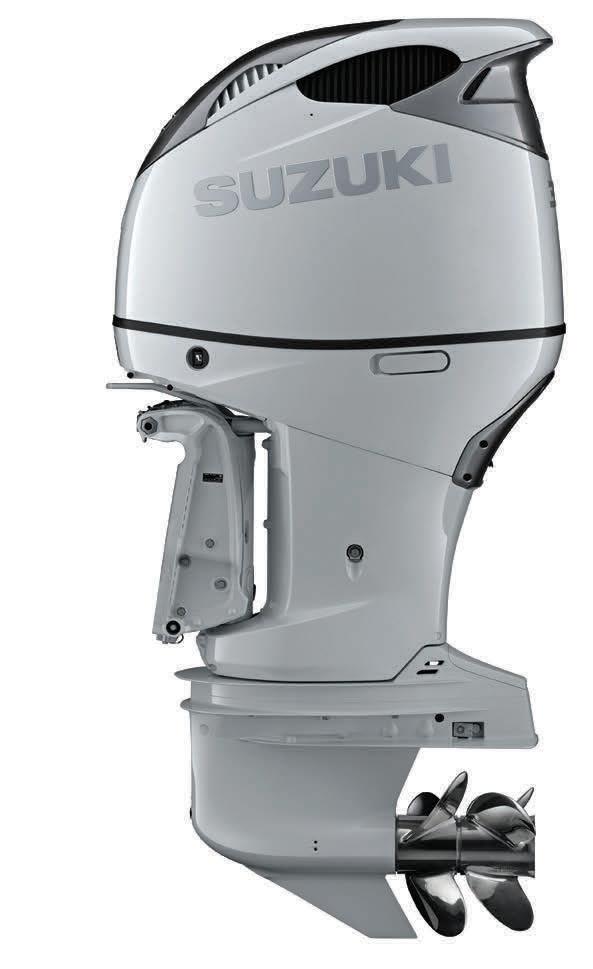



When you purchase a new Suzuki outboard from an authorized Mastry RePower Center you qualify to become a member of the Mastry Suzuki Owner’s Edge. Owners receive an identifcation card that provides them with important information about their Suzuki outboard motor as well as a passport to additional benefts during ownership. Members enjoy a detailed engine maintenance schedule, Mastry Suzuki RePower Trade Program and special pricing from Mastry Suzuki Partners *Get with the Program!

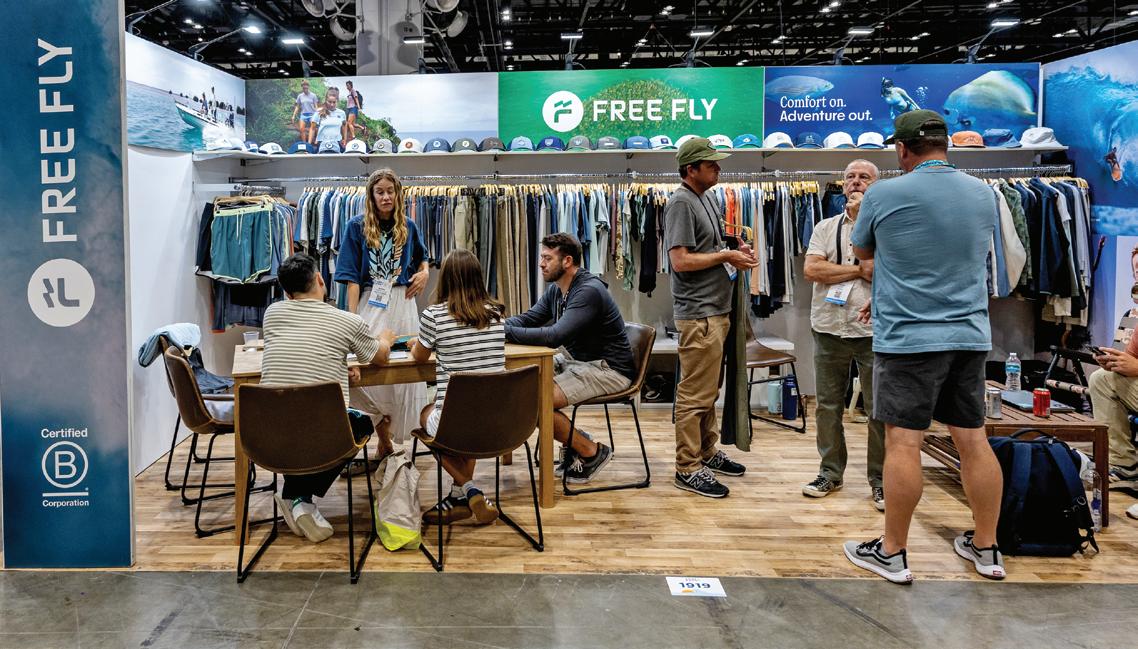
In the world of watersports and outdoor lifestyle, staying connected to what’s next isn’t optional—it’s essential. For 50 years, Surf Expo has been where the industry comes together to discover new products, make connections, and set the tone for the season ahead.
Returning to the Orange County Convention Center in Orlando, January 7–9, 2026, Surf Expo celebrates its 50th anniversary with an event that honors ve decades of driving the business of the waterman lifestyle forward. e show draws thousands of quali ed retail buyers, brands, and industry professionals from across the U.S. and around the world.
Surf Expo has long been the industry’s launchpad for what’s next. It’s where new brands make their debut and where trusted names unveil their latest collections. On the show oor, sustainability, functionality, and style continue to drive the next wave of coastal and outdoor retail—trends that shape what ends up in your store and, ultimately, in the hands of your customers.
Re ecting the growing connection between coastal and outdoor lifestyles, Surf Expo’s Shoreline Outdoor area continues to expand— bringing together products designed for life on the water and adventures on land. is growing segment highlights essentials for outdoor adventure, from versatile apparel and gear to innovative accessories that move seamlessly from coast to camp.
Shoreline Outdoor features brands and products that bridge categories—boating, shing, paddling, hiking, and camping—meeting consumer demand for versatility and performance. Retailers will nd quality, functional, and sustainable products built for modern outdoor enthusiasts. ink waterproof bags, insulated coolers, portable re pits, backpacks, multifunctional jackets, and drinkware designed for any setting. is lifestyle focused area captures the spirit of adventure—friends gathered by a re pit a er a day on the water, paddleboards pulled up on the sand, or cozy campsites under starlit skies. It’s all about embracing the outdoors in every way.
What makes Surf Expo such an essential stop on the retail calendar? It’s the unmatched variety. Hardgoods, apparel and accessories that bridge the gap between beachwear and everyday wear, Surf Expo delivers products that de ne coastal and outdoor living. Whether your customers are anglers, surfers, paddleboarders, kayakers or simply love the water or the outdoors, you’ll nd fresh lines and innovations that resonate.
Surf Expo remains much more than aisles of product—it’s a place to learn, connect and recharge your business strategy. Educational sessions, in-booth demos and networking events o er valuable insights into consumer behavior, merchandising and market trends.
Join them January 7–9, 2026 as they celebrate 50 years of Surf Expo— and experience rsthand why this show continues to be the heartbeat of the coastal and outdoor lifestyle industry.
Quali ed retail buyers register for free before 12/24 at surfexpo.com

By Mark Ambert

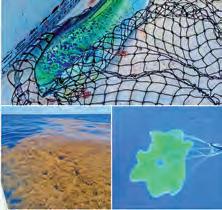
There’s magic in the way a mahi mahi lights up when it crashes a live bait. Electric greens, yellows, and blues; all pulsing with life, like the ocean itself. If you’ve ever tangled with one, you know: it’s not just a fish, it’s a fullblown spectacle. And there’s no more thrilling way to target these pelagic acrobats than with live bait.
Live bait fishing for mahi is less about brute force and more about finesse. It’s knowing when to drift and when to troll, when to freeline and when to pitch. You’re not just dropping bait in the water, you’re offering an invitation and if you do it right, the ocean answers in brilliant chaos.
Let’s start with the basics. Find the frigate birds. Look for flying fish and blue water. Find that patch of weed holding bait. Watch the water. The mahi are rarely where you want them to be, but always where they ought to be. Current edges, floating debris, weed lines, these aren’t just features; they’re dinner tables. Approach quietly. Keep your eyes sharp. That flicker of green behind the weeds? It’s not a mirage. That’s your quarry. Live bait selection matters. Pilchards, cigar minnows, finger mullet; they all have their place. But few offerings rival a lively sardine or goggle eye when it comes to pulling big mahi out of their hideouts. Hook your bait through the nose or shoulder to let it swim true, and with a hook sized appropriately to the bait, not the quarry. Use as light a leader as the situation allows, fluorocarbon in the 30 to 50-pound range is the sweet spot.
Drifting is deadly when conditions are right. Kill the engines and let the bait do the talking. You’ll often see the mahi before they hit darting from the shadows like a comet to inhale the offering. When they do, don’t rush. Let them eat. Reel down, come tight, and hold on. The first run is a blur, the jumps are ballistic, and the colors are unforgettable.
If you can, inspect what’s in their stomach and you’ll know what and where they are actually feeding.
Once found, do everything possible to keep them around the boat. You might not see another school for the rest of the day. I like to deploy a chum bag first then a mylar teaser followed by cut bait. Small pieces and only three or four at a time. Wait ten minutes in between adding more chum to the water.
Sometimes, slow trolling a few live baits is the key to raising a school. Goggle eyes are hearty swimmers and perfect for this method. Once set up, a one-ounce jig can get the attention of the deeper cruising bulls, while a flat-lined bait dances just beneath the surface. To keep live baits from tangling, deploy them at different distances from the boat. Keep a pitch rod ready with a fresh squid bait as mahi are curious, and when one shows, more often follow. Fish on? Toss a bait behind the hooked fish and get ready. The frenzy happens fast!
The beauty of live baiting is the connection. You see and feel the bait’s urgency through the line, and when the mahi comes tight, it’s like the

ocean suddenly comes to life. It’s primal. So next time you’re chasing the green, do yourself a favor, go live. Let the bait do the work. Let the fish come to you. Because sometimes the most productive rhythm is the one nature writes. And when that mahi clears the water, shaking its head in defiance, gleaming like a sunbeam with fins, you’ll know, you did it right.
Mark Ambert, IG @marksgonefishing_™ Equipment Used - Coastal Fishing https://www.coastalfishing.com/
Please be sure to check out my YouTube Channel “Darcizzle Offshore” for fishing videos every week! www.youtube.com/DarcizzleOffshore
The “mullet run” should be drawing to a close right around the beginning of November. There should still be bull sharks, snook, and tarpon crushing the remaining schools that are migrating through, so this is your last call to get out and enjoy the hot inshore bite. Follow the mullet for excellent snook and tarpon fishing inshore and along the beach. If tarpon and snook are biting, you can catch them on a live mullet using a circle hook or any number of swimming baits and “flair hawks.” I’ve caught many snook and quite a few tarpon using this method.
Offshore, November should start bringing sailfish into the area, wahoo, and bigger-sized mahi mahi. In the Palm Beaches it’s most popular to kite fish with live bait for these pelagic fish, but slow trolling live bait works nearly as well. Trolling ballyhoo and lures will also land you plenty of sailfish and mahi. If it’s calm, head offshore and find some floating debris or other structure that holds bait that the mahi feed on. November weather will bring more northerly winds and cooler, less humid, drier weather which translates into rougher seas. If it’s rougher stay close and troll those ballyhoo for sails and mahi from 80-
300 feet or deeper depending on water conditions. You should be on the look for color changes and temperature breaks.
Closer to shore and on the bottom, fishing will be excellent! The fall run of Spanish mackerels should also be showing up in good numbers and are so much fun to catch on light tackle. The party boats will be coming in with a good number of yellowtails and large mutton snappers. Even mahi mahi have been caught shallow recently, presumably chasing mullet closer to shore than normal. There have been a good number of kingfish landed as well, however bigger kingfish have been missing from the Palm Beaches for several weeks. The drift boats typically use a triple-hook rig with a whole dead sardine as bait. This is a great yet simple fishing method and will catch you plenty of fish; I have caught a sailfish in the past with this simple rig so don’t count it out when you just want to relax on the water.
Caught a keeper, speckled seatrout on a piece of cut shrimp inshore fishing during the mullet run!


















































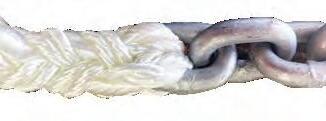









www.swamptosea.com • 561-503-0848
Here is your November inshore, near shore, and freshwater fishing forecast.





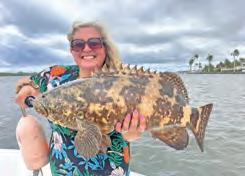
It’s a great time of the year for catching multiple species that we can eat. Inshore, as the spillway should be closed, the water should be getting cleaner with every tide. Before you head out, it would be a good time to make sure you have the Florida State regulations. There are plenty of apps that you can download on your phone that will give you this information. Most of my fishing in November takes place in the Intracoastal and some along the beach. In the Intracoastal I am looking for deep water channels, deep docks, and places where the fish can find steady temperatures. It’s not quite as important as it’s in December or January, but you will notice certain schools and types of fish moving into their winter areas. There are too many species to list, but the tackle is pretty simple and will catch just about everything that swims. A 6-to12-pound spinning set up with a 2500 sized reel and 8-pound braid is my goto. My lure selection is also simple, as I will fish Gulp Shrimp if there are no live shrimp available or if somebody wants to just fish artificial. If we are using live or fresh shrimp, I will use a small white bucktail and tip it with a piece of shrimp. Bounce this along the bottom and it won’t be unusual to catch a dozen or more species in a day. If you’re going to fish around the inlet you need to be prepared for bigger jacks so definitely scale up your tackle as your bites will be deeper and the fish will be a lot stronger. On the beach, throwing a top water or a spoon will probably get you action from bluefish, ladyfish, jacks, and more. If you’re interested in pompano or permit, you might want to try a pink and white or yellow and white goofy jig.
Florida’s stone crab season is officially underway! These iconic crustaceans are a local favorite, prized for their sweet, succulent claws. What makes stone crabbing so unique is the sustainable nature of the fishery. Only keepersized claws are harvested, allowing the crab to survive and grow them back, ensuring healthy populations for years to come. If both claws are keeper size, you are legally allowed to harvest both, but we usually take just one claw to give the crab a stronger defense against predators. When it comes to bait, we’re big fans of pig feet. They’re durable, stinky, and take a long time to decay, but chicken thighs, chicken necks, and fish carcasses work well too. Fish carcasses decay quickly, so traps should be checked every three to five days, whereas pig feet allow for a longer soak of around ten days. For the best results, we like to combine fish carcasses and pig feet to attract crabs quickly and keep them feeding for longer.


In the freshwater, everything will be eating and happy to see you. Live shiners always get the most action but don’t be scared to throw an artificial where you can actually cover a lot more ground with them. If you’re going to fish the main lakes, a chrome rattle trap with or without a black dot in the back is a great choice. In the canals, I prefer an unweighted fluke or some sort of suspended jerk bait. On nasty windy days, right at sunrise, there’s usually a good opportunity to find sunshine bass blitzing. It doesn’t last long so you have to get your lure in there as fast as you can, as it can make for some fast, solid action. Good luck out there!


So, where should you drop your traps? We like 5 to 15 feet of water over rocky or mixed bottoms and avoid sandy areas. Stone crabs thrive in spots with plenty of current and structure, so look for rocks, shells, or other debris that give crabs cover. Our top crabbing spots often change from season to season, so finding the right areas usually comes down to trial and error. At the start of the season, we put traps in several spots and narrow it down to one or two as production guides us.
Once you’ve got your claws, cook them as soon as you get back to the dock. One of our best tips is to grab a bucket of clean seawater while out crabbing (please don’t grab water from the ramp!) and boil the claws in it on your stove. Depending on the size, boil for 8 to 10 minutes at a rapid boil, then let them cool. Serve on ice or enjoy warm with some drawn butter! For more details and a step-by-step how-to video, check out our YouTube channel @GaleForceTwins. We share tons of stone crabbing tips, tricks, and advice to help make your season a success. Whether you’re a seasoned pro or trying it for the first time, there’s nothing quite like pulling up a trap full of claws on a sunny Florida morning.
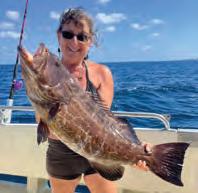

•
•
Join Us & Catch:
King Mackerel • Wahoo
Dolphin • Snapper (all kinds)
Sailfish • Grouper
Bonito • Cobia
All licensing, bait & tackle included. + gratuity for crew
ADULTS: $60 per person
Discount Rates (cannot be combined with any other discounts)
$55 - Seniors
(Over 65, Weekdays Only)
$55 - Active Teachers, Military, Law Enforcement
$45 - Children 12 & under $50 VIP Program































































772-201-5899 • Brian@tckayakfishing.com • tckayakfishing.com
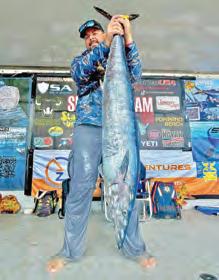
Yours truly with a tournament wahoo.

Ian caught this nice mahi.
November will be the start of the inter species push. Look for pompano, Spanish mackerel, and bluefish to start to show up along the beach with our first few cold fronts. Fish for pompano along channel edges of your favorite inlet. Pompano jigs, D.O.A. Lures 2.75” shrimp, and a good ole bucktail jig are a few of my favorite lures. A favorite place to kayak fish for these fish is the Intracoastal north of Jupiter Inlet, east of Jonathan Dickenson State Park.

Last month I mentioned how subtly fall arrives here in South Florida. It takes some time to get used to the slower pace of change, as fall weather patterns tend to develop much more gradually here than up north. But by November we’re usually settling into a regular routine of northerly breezes, beautiful weather, and glorious sunrises and sunsets.
One cue that fall is on the way is the arrival of migrating birds from elsewhere in North America. Bird migrations happen all year long in various parts of the globe, but they are most noticeable in Florida during our spring and fall. And as you’ll no doubt notice, many winter Florida residents (both people and birds!) start to arrive in droves in November.

Myself with a nice kingfish.

Braxton reeled in a good clown knifefish.
November has traditionally brought me some good wahoo and mahi catches. We typically get good numbers more than size this time of year on the mahi. If you can still find mullet around, I love using them for mahi drifting in 90-150’ of water. I like to bump up my bait size for the wahoo and slow troll goggle eyes and blue runners in 90-250’ of water. Try trolling one bait up top on the surface and one at 40-80’ below the surface using a downrigger of rubber band and egg weight attached to your line. The egg weight will break away when the bait is hit, and you are free to fight the fish.
Peacock bass and clown knifefish will be chewing this month. Yo-Zuri Prop Baits will work well for peacocks along shallow edges. Try twentypound leader and a 2/0 circle hook casting in and around structure and weed lines to get onto a few clowns with finger mullet and shiners. Look to fish mid-water column and below by adding a pinch weight to your leader and get that bait in their face.
the internal structure of weather fronts and storms. They can detect rain, updrafts, downdrafts, and rotation of weather cells within clouds. This gives forecasters the ability to better predict severe weather. And curiously, that very detailed imaging can even spot migrating birds!
Last month, composite radar images highlighted huge circular flocks of birds on the move during their late-night flights. Many birds prefer to migrate after dark, taking advantage of more predictable winds and more calm conditions than are often found during daylight hours.

For people watchers, one of the first signs that “snowbird” migration season has started are the car carriers that arrive daily with more cars and more traffic for our roads. It’s admittedly a pretty low-tech way to gauge the start and end of snowbird season, but a reliable one too!
At the other end of the tech spectrum, bird watchers have taken things to the next level by employing the use of radar to monitor migration activity. Weather forecasting has gotten a lot more advanced in the last decade or so. Many newer radar systems are sophisticated enough to highlight
One of the best examples of this happened was just last month. While the twin hurricanes Humberto and Imelda were churning their way through the Atlantic Ocean, radar detected massive flocks of birds all headed south at roughly the same speed. It turns out that the storms had created a strong tailwind for the birds, allowing them to fly with little effort all night long at 30+ mph. The ultimate free express lane for our fine feathered friends!
Radar can’t discern what bird species are on the move...that’s up to birders and birding clubs, of which it seems like there are more every day! Once an activity almost exclusively associated with older retirees, birding has become much more popular with younger wildlife and nature enthusiasts.
There are some great opportunities for bird watching throughout Florida and especially in South Florida. I’ll cover some good and great spots to go birding in future columns.
Until then, hope to see you on the water!

Capt. Weston Russell • www.reelintensefishing.com •561-310-2690

Another successful troll day for this young lady. Wahoo is what’s for dinner!
Welcome to the Coastal Angler Magazine Palm Beaches November forecast. This is the month that kicks off sailfish season. Dust off your kites and change the clips on the reels, as we’re going to be getting down and dirty. Sailfishing is very popular off our beaches and it’s one of the few fish that we catch and release. This is the key reason we have such a successful season every year. If you think you’re pretty good at sailfishing, you should try your luck at one of the many tournaments going on in the winter. If you don’t really care about catching sailfish, there’s plenty of other fish to catch. Let’s now talk about the speedy wahoo, this fish is bad to the bone! When this fish bites, you will know, because they pull drag out for long distances. We catch wahoo trolling either on planers or cigar leads, but many are taken on the kite rigs. So, when you’re kite fishing, make sure you’re fishing a few rigs with wire just in case you get that toothy critter bite. Another fish to be caught this month is dolphin, aka mahi. The days of the giant mahi are long gone, but you can still catch some that are in the 20-to-30-inch range. Trolling or kite fishing works the best for these of pelagics. If you’re just drift fishing the Gulf Stream, you have a good chance of multiple catches. These fish like to group together and watch out when they get into a feeding frenzy, it’s epic!
For the inshore angler, there is going to be some great opportunities on the beach. There will still be some fish left over from the mullet run like high jumping tarpon and drag screaming jacks. I would definitely be fishing the outgoing tide outside of the Palm Beach Inlet. Another good spot to fish is at MacArthur State Park. There are a lot of rocks there for fish to hide around and ambush baits but be wary as rocks have taken a toll on some of those lower units. November is generally pretty windy, but we might get lucky this month with a few nice days, especially if there’s some west winds. Well, that’s all I got for you, but I’ll give you one last tip, you can’t catch them from the couch!




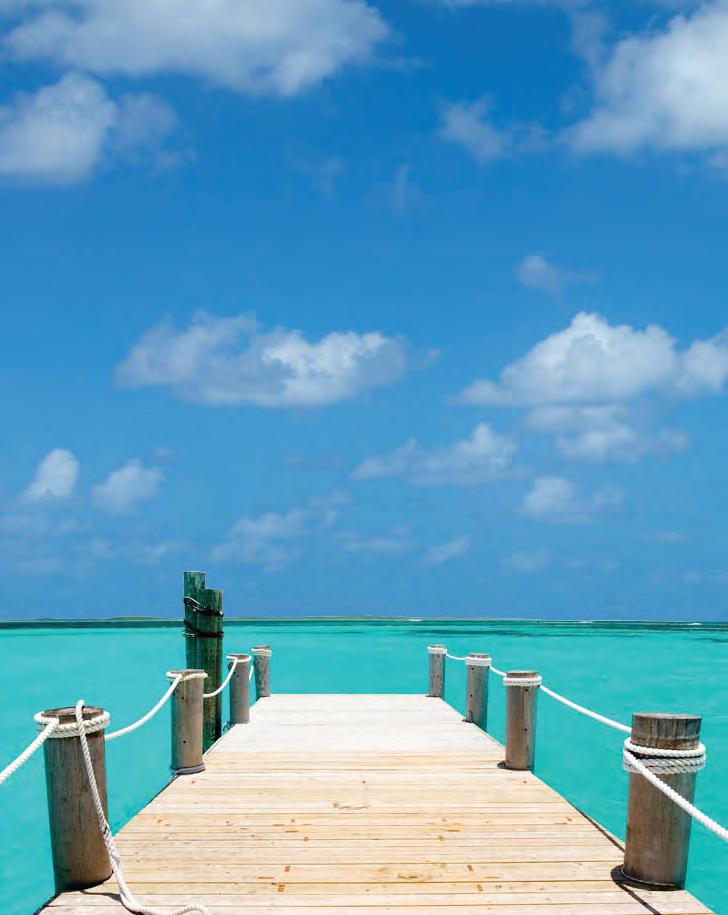































PhlatsInshoreFishing.com • (561) 644-4371
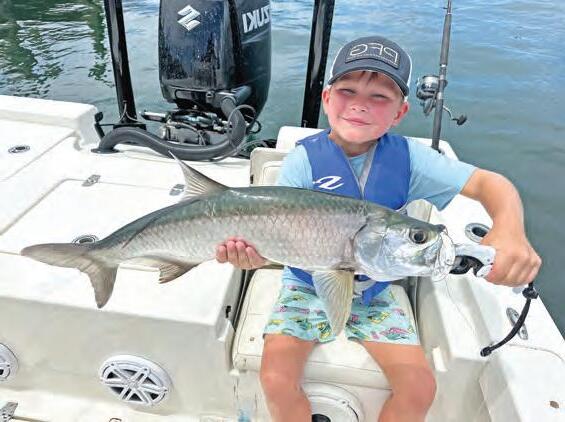
Happy Thanksgiving! The Palm Beaches in November can have moderate and cool temperatures. Cooler weather will bring down water temperatures and predator fish will begin to push into back bays, canals, and coves.
Snook fishing in Jupiter and Palm Beach will provide anglers steady action along seawalls, mangrove shorelines, and channel edges. Sight fishing on the flats is another option for those who enjoy watching the bite. A D.O.A. C.A.L. 3” Shad or a D.O.A. 3” Shrimp presented in the right spot will get the drag screaming.

Tarpon will now be migrating into back bays and canals offering excellent fishing for the silver king. Tarpon are prevalent inside the ICW, mangrove shorelines, docks, and deep passes. Live shrimp drifted with the tide is the best bait, but other baits like mullet, pinfish, and greenies work as well. Artificial enthusiasts, the deeper passes offer plenty of shots on D.O.A. Bait


Busters or D.O.A. C.A.L. 3” Shad Tails. Tarpon this time of year range from 10 to 60 pounds.
November also offers great action for big jack crevalle on the ICW. Jacks will pounce on a Rapala Skitter Walk or live bait in the vicinity of seawalls, docks, or open water flats. The jacks are schooling fish averaging 5 to 25 pounds. Battling jacks on light tackle or fly is something an angler will never forget, come experience the tussle yourself.
Well, that is the fishing report for the Palm Beach and Jupiter area. I hope you all enjoyed, so get out there and get hooked up. Tight lines!































South Florida Fishing Charters • (954) 440-5200 • sflfishingcharters.com

November is hands down my favorite month to fish. It’s when we finally get that first real taste of fall; comfortable weather, light breeze, and steady action on the water. The Lake Ida Chain has been on fire lately with solid numbers of peacock bass, snakeheads, and clown knifefish. Most people don’t think of Ida as a cichlid spot, but if you take the time and drop a few live worms, you’ll stay busy. It’s especially fun for kids or anyone who just wants consistent bites.
The peacocks are about to go through their usual seasonal cycle. There’s always a chance for an early spawn before winter. When the water drops below 80 degrees for a bit and then warms back up, it tricks them into thinking winter came and went, so they spawn. Then, when the real winter arrives, they protect their fry and often get another spawn in spring. That exact double spawn happened last year, and you can tell, because we’re seeing a ton of healthy onepounders from that class. Peacocks grow fast, roughly a pound and 12 to 14 inches in their first year, and then they pack on weight quickly. I have lots of favorites for artificial lures when it comes to peacock fishing, and in the fall, I tend to downsize my presentation and fish the Pig Jigs, underspin, where the “Dirty P” is one of my all-time favorites.
Clown knifefish have been active too, especially after all the rain South Florida has gotten recently. If the clouds roll in, that’s your cue to go hunt clowns. Aside from catching them on live bait as they’re a blast on artificials,


my go-to is a 5” Z-Man StreakZ on a Texas Eye Jig, worked low and slow along the bottom. Snakehead fishing in the fall can also be really productive and a lot of fun. Snakeheads are most active from first light for the next hour or two, and in the evening of the last few hours of daylight. For snakeheads this time of year my go-to is a chatter-bait with a minnow like trailer, something long with a good action. When “snekin” around I always keep a frog rod ready, you never know when you’ll find them tucked up under the heaviest cover.
The Everglades is holding a lot of water, but live bait will get you plenty of action around moving water and the bridges. Once we get closer to spring and the water level drops, I expect things to really fire up. It’s been a few years since the last big fish die-off out there, so we’re due for an incredible season. And don’t sleep on the cichlids out there, they’re fun to catch and great on the dinner table, you can fill up a bucket in no time.




• Great Customer Service Unlimited

• Florida Concealed Weapons Classes
• Firearms Training Courses
Beginner to Advanced & Private Classes
Provided by Florida Firearms Training
• Fully Air Conditioned Range
• Maintained at 72 Degrees


















10:19 3.3 3:42 -0.2 4:15 0.6 6:34 5:33
9 Sun 11:07 3.4 11:17 3.2 4:38 0.1 5:14 0.7 6:35 5:33 10 Mon 12:04























































November is hands down my favorite month to fish. It’s when we finally get that first real taste of fall; comfortable weather, light breeze, and steady action on the water. The Lake Ida Chain has been on fire lately with solid numbers of peacock bass, snakeheads, and clown knifefish. Most people don’t think of Ida as a cichlid spot, but if you take the time and drop a few live worms, you’ll stay busy. It’s especially fun for kids or anyone who just wants consistent bites.
The peacocks are about to go through their usual seasonal cycle. There’s always a chance for an early spawn before winter. When the water drops below 80 degrees for a bit and then warms back up, it tricks them into thinking winter came and went, so they spawn. Then, when the real winter arrives, they protect their fry and often get another spawn in spring. That exact double spawn happened last year, and you can tell, because we’re seeing a ton of healthy one-pounders from that class. Peacocks grow fast, roughly a pound and 12 to 14 inches in their first year, and then they pack on weight quickly. I have lots of favorites for artificial lures when it comes to peacock fishing, and in the fall, I tend to downsize my presentation and fish the Pig Jigs, underspin, where the “Dirty P” is one of my all-time favorites.

Clown knifefish have been active too, especially after all the rain South Florida has gotten recently. If the clouds roll in, that’s your cue to go hunt clowns. Aside from catching them on live bait as they’re a blast on artificials, my go-to is a 5” Z-Man StreakZ on a Texas Eye Jig, worked low and slow along the bottom.

Snakehead fishing in the fall can also be really productive and a lot of fun. Snakeheads are most active from first light for the next hour or two, and in the evening of the last few hours of daylight. For snakeheads this time of year my go-to is a chatter-bait with a minnow like trailer, something long with a good action. When “snekin” around I always keep a frog rod ready, you never know when you’ll find them tucked up under the heaviest cover.
The Everglades is holding a lot of water, but live bait will get you plenty of action around moving water and the bridges. Once we get closer to spring and the water level drops, I expect things to really fire up. It’s been a few years since the last big fish die-off out there, so we’re due for an incredible season. And don’t sleep on the cichlids out there, they’re fun to catch and great on the dinner table, you can fill up a bucket in no time.
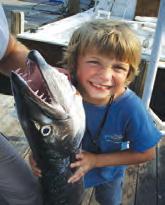





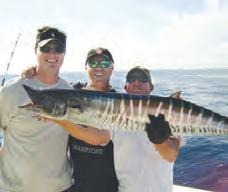



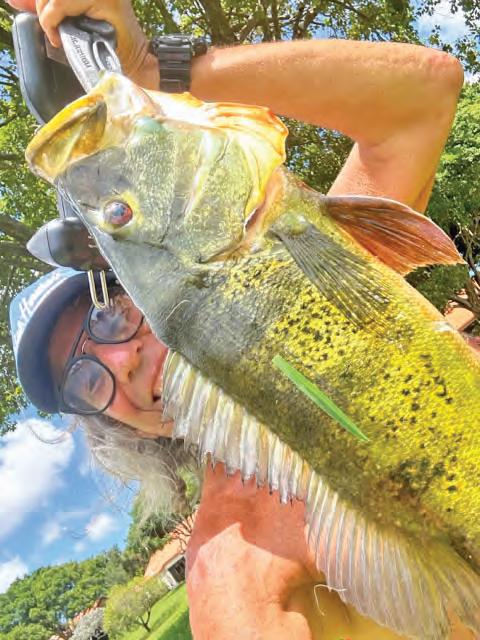
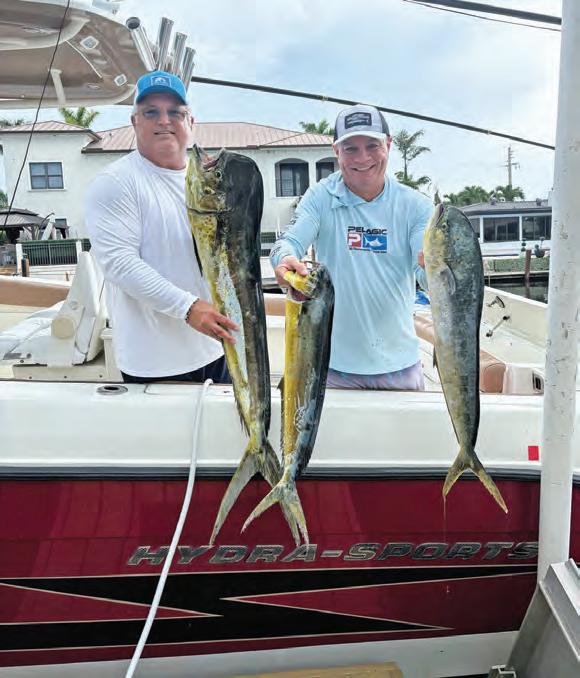
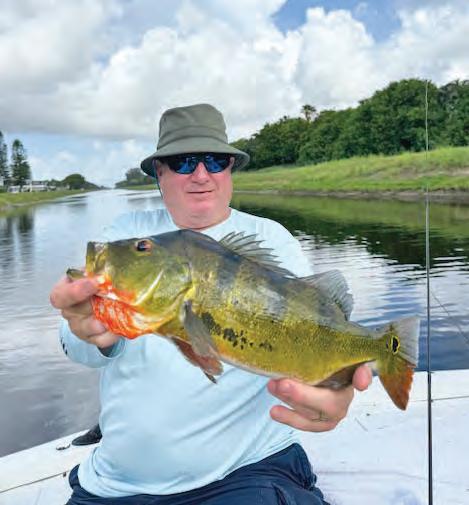

Owen Clancy reeled in his first wahoo, a 50 pounder off Jupiter.





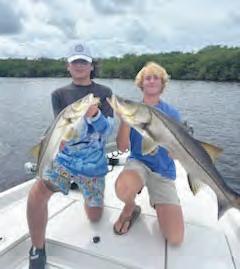


The Marine Industries Association of Palm Beach County (MIAPBC) is celebrating boaters with special raffles, early bird perks, and a new “Rookie of the Year” award.
The Marine Industries Association of Palm Beach County (MIAPBC) is celebrating boaters with special raffles, early bird perks, and a new “Rookie of the Year” award.
ake to the waterways during Palm Beach County’s most beloved holiday tradition, the 31st Annual Palm Beach Holiday Boat Parade. Boat registration is free and open now through December 2. This year, participants will have the chance to win cash and other prizes in special raffles, and early registrants will have their $50 refundable deposit waived.
ake to the waterways during Palm Beach County’s most beloved holiday tradition, the 31st Annual Palm Beach Holiday Boat Parade. Boat registration is free and open now through December 2. This year, participants will have the chance to win cash and other prizes in special raffles, and early registrants will have their $50 refundable deposit waived.

Presented by the Marine Industries Association of Palm Beach County (MIAPBC) and Lessing’s Hospitality Group, the 31st Annual Palm Beach Holiday Boat Parade will kick off the holiday season on Saturday, December 6 at 6 p.m. This free, family-friendly event features up to 80 boats led by a traveling Zambelli fireworks display along the Intracoastal Waterway from North Palm Beach to the Jupiter Inlet Lighthouse. The parade supports Toys for Tots and Little Smiles by collecting toys along the parade route and at designated locations on land. Last year, MIAPBC collected more than 10,000 toys to support children in the community.
Presented by the Marine Industries Association of Palm Beach County (MIAPBC) and Lessing’s Hospitality Group, the 31st Annual Palm Beach Holiday Boat Parade will kick off the holiday season on Saturday, December 6 at 6 p.m. This free, family-friendly event features up to 80 boats led by a traveling Zambelli fireworks display along the Intracoastal Waterway from North Palm Beach to the Jupiter Inlet Lighthouse. The parade supports Toys for Tots and Little Smiles by collecting toys along the parade route and at designated locations on land. Last year, MIAPBC collected more than 10,000 toys to support children in the community.
For the first time ever, the parade is offering exclusive perks for early boat registration. Boaters registered by Wednesday, November 19, will be entered into two raffles: the chance to win two tickets to the Windward VIP Club at the Palm Beach International Boat Show, valued at $950, and the chance to win $500 cash.
For the first time ever, the parade is offering exclusive perks for early boat registration. Boaters registered by Wednesday, November 19, will be entered into two raffles: the chance to win two tickets to the Windward VIP Club at the Palm Beach International Boat Show, valued at $950, and the chance to win $500 cash.
A panel of judges will evaluate each vessel based on lights displayed, enthusiasm, and themed décor. Boaters will compete across a range of categories, including “Best of Parade,” “Fan Favorite,” and “Corporate,” with more than $10,000 in cash and prizes on the line. The parade will debut a new category for new participants called “Rookie of the Year,” featuring a custom award, $250 cash, and more.
A panel of judges will evaluate each vessel based on lights displayed, enthusiasm, and themed décor. Boaters will compete across a range of categories, including “Best of Parade,” “Fan Favorite,” and “Corporate,” with more than $10,000 in cash and prizes on the line. The parade will debut a new category for new participants called “Rookie of the Year,” featuring a custom award, $250 cash, and more.
Boat registrants are required to attend the captain’s meeting at 6 p.m. on Tuesday, December 2, at The Twisted Tuna. Registration is available online at palmbeachboatparade.com or by calling (561) 863-0012.








Make your boats shine bright this season during the 31st Annual Palm Beach Holiday Boat Parade!
Boat registrants are required to attend the captain’s meeting at 6 p.m. on Tuesday, December 2, at The Twisted Tuna. Registration is available online at palmbeachboatparade.com or by calling (561) 863-0012. Make your boats shine bright this season during the 31st Annual Palm Beach Holiday Boat Parade!
















By Joey Bloom, Copper State Tackle Tournament Pro
There’s nothing quite like the rst real cold front of fall in the Southeast. One week you’re wearing a short-sleeve shirt and chasing schooling sh under bluebird skies, and the next, you’re bundled up, watching your breath in the morning fog, wondering where those sh disappeared to. When the water temps take that rst noticeable drop— usually sliding from the mid-70s into the 60s—it marks a big turning point in fall shing. e bass feel it too, and their behavior changes almost overnight.

A er a strong cold front, the rst thing I notice is how much tighter sh get to cover. ose aggressive, roaming schools that were chasing bait across shallow ats will suddenly scatter. e sudden high pressure that follows a front can make sh sulk and suspend, and the feeding windows get short. It’s not that they stop feeding entirely—they just reposition and get more selective. For me, this is when slowing down and thinking about the why behind each cast becomes crucial. Bass are still following the bait—usually shad— but their movements tighten up. I’ll start by checking shallow areas near deep water access, like secondary points, creek channel bends, or riprap banks near the mouths of pockets. ese are transition zones where bass can adjust depth easily as the temperature and pressure uctuate.
When those water temps dip, I turn to con dence baits that match the conditions and the mood of the sh. A lipless crankbait is one of my rst picks—it gives o a rattle and tight wobble that’s perfect for cooler water. I’ll run something like “Bill Lewis” 1/2 oz trap in a natural shad colors along



shell bars, grass patches, or around isolated wood. e key is to sh it methodically—make contact with cover and pop it o en. If the lipless bite feels o , I downshi into nesse mode. A 1/2-ounce jig with a Bait Cave Customs Cave Cricket Craw trailer is deadly around docks, brush, or isolated laydowns. I’ll pitch it on lighter line and really soak each piece of cover. e colder the water gets, the longer I’ll let that bait sit.
Another underrated player this time of year is a suspending Rapala jerkbait. When bass suspend er a front, that slow, twitch-pause-twitch cadence can trigger bites from sh that otherwise wouldn’t move far. On high-pressure bluebird days, I might make a cast, let the bait sit ten seconds, and only then give it a twitch. It’s all about patience and timing.
e best post-front patterns o en come down to consistency. Look for areas with a stable food source—places where bait sh stack up despite changing conditions. In reservoirs across the Southeast, that might mean a windblown main-lake point one day and a calm pocket the next. Keep an eye on your electronics, follow the bait, and don’t be afraid to adjust your depth until you see life.
Cold fronts separate the patient from the impatient. It’s a time to slow down, sh smart, and make every cast count. e bass might be moody, but they’re still there—and with the right mindset and a few Copper State Tackle baits on your line, you can turn those tough post-front days into opportunities.
Pro Tip: When in doubt, start with a lipless crankbait to cover water and locate active sh. Once you nd them, pick up a jig or shakey head with a Bait Cave Customs ick Stick worm to milk the area for those extra bites. You can grab both at Copper State Tackle—the gear I trust when every ounce matters. Follow all of Joey Bloom’s shing and fun on Instagram, Facebook, and YouTube at Joey Bloom Fishing.







ShoreStation hydraulic boat lifts are a reliable choice for coastal residents and boating enthusiasts alike. Their strong construction, made with corrosion-resistant materials, allows them to withstand harsh environmental conditions, including sun, storms, and saltwater damage. ShoreStation provides a steadfast solution for protecting waterfront investments, o ering peace of mind to owners in the Sunshine State.
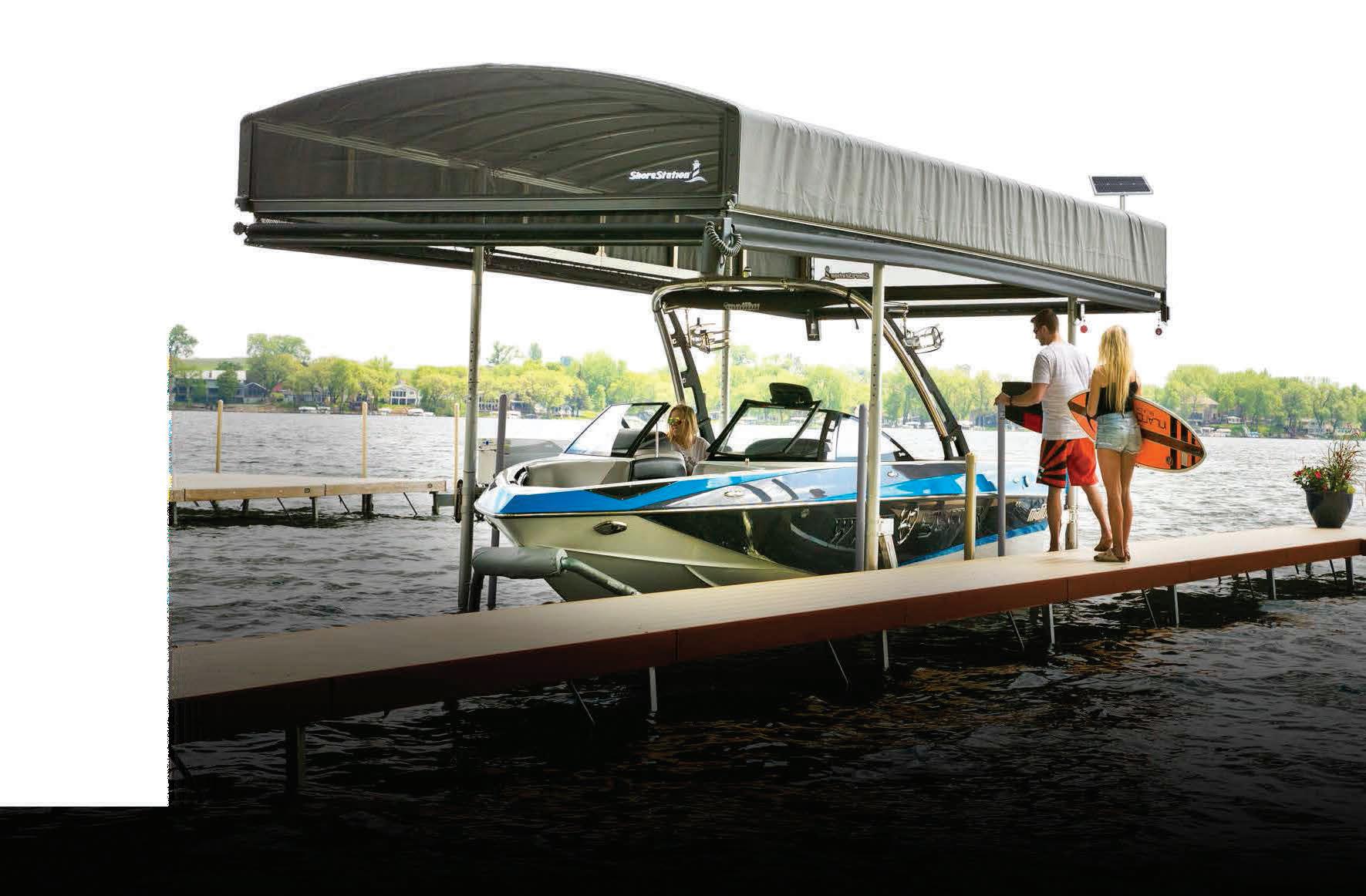

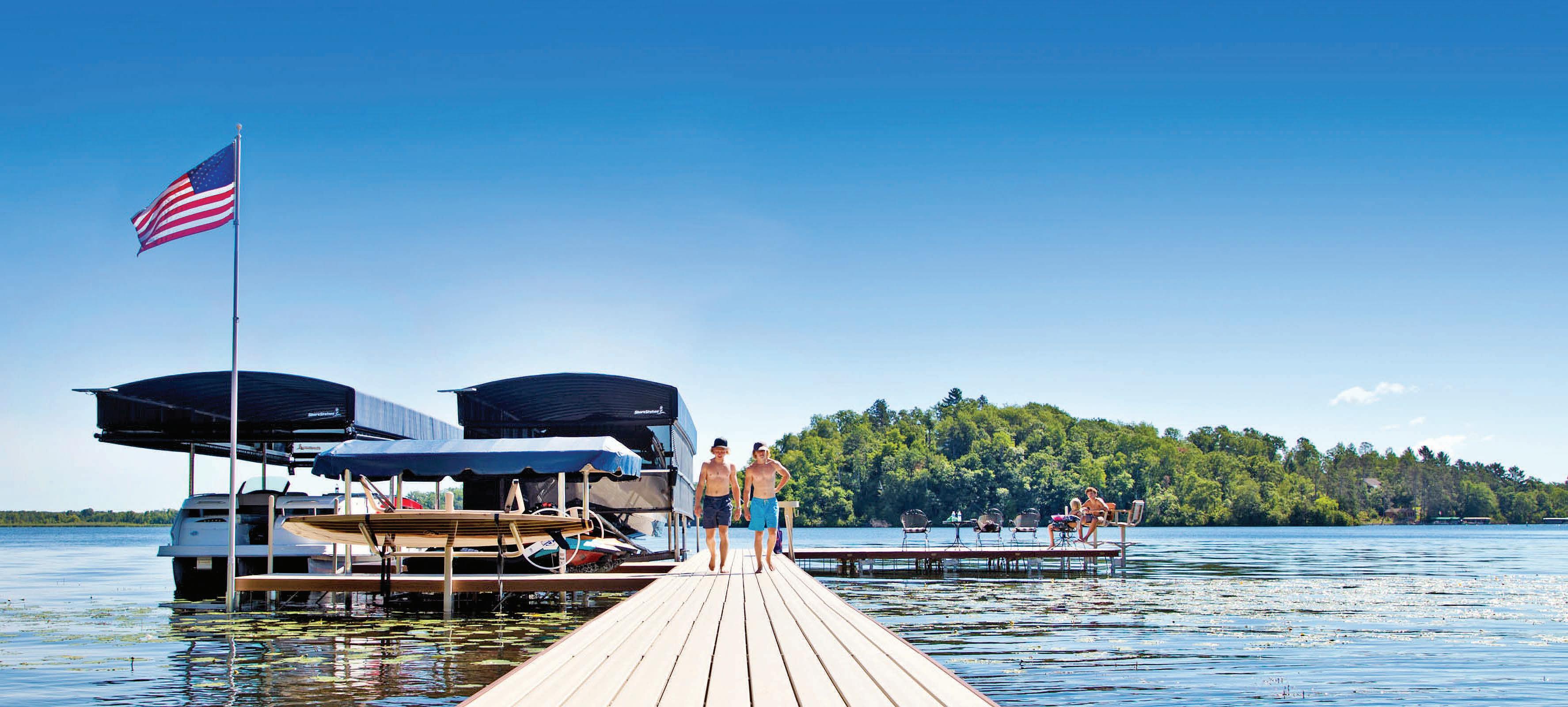




Equipped with exceptional weather resistant fabric and breathable SunTex 80 woven mesh ends for maximum protection and durability,

Made from the highest quality materials, our innovative hydraulic boat lift is one of the fastest and safest lifts on the market today. When you have a hydraulic lift, there’s no need to worry about wind and waves getting in your way. This lift will give you con dence to safely land and secure your boat in less-than-ideal conditions.
Never miss another moment on the water. Power your lift with clean, free solar power. Our speedy 20 watt charger features solar regulator drainage protection, saving your battery from permanent damage caused by overcharging.







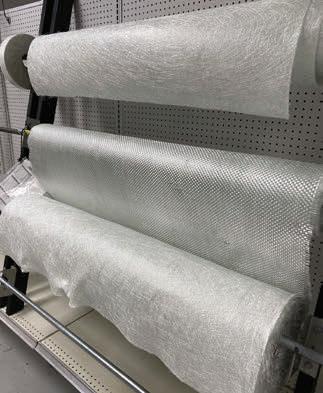
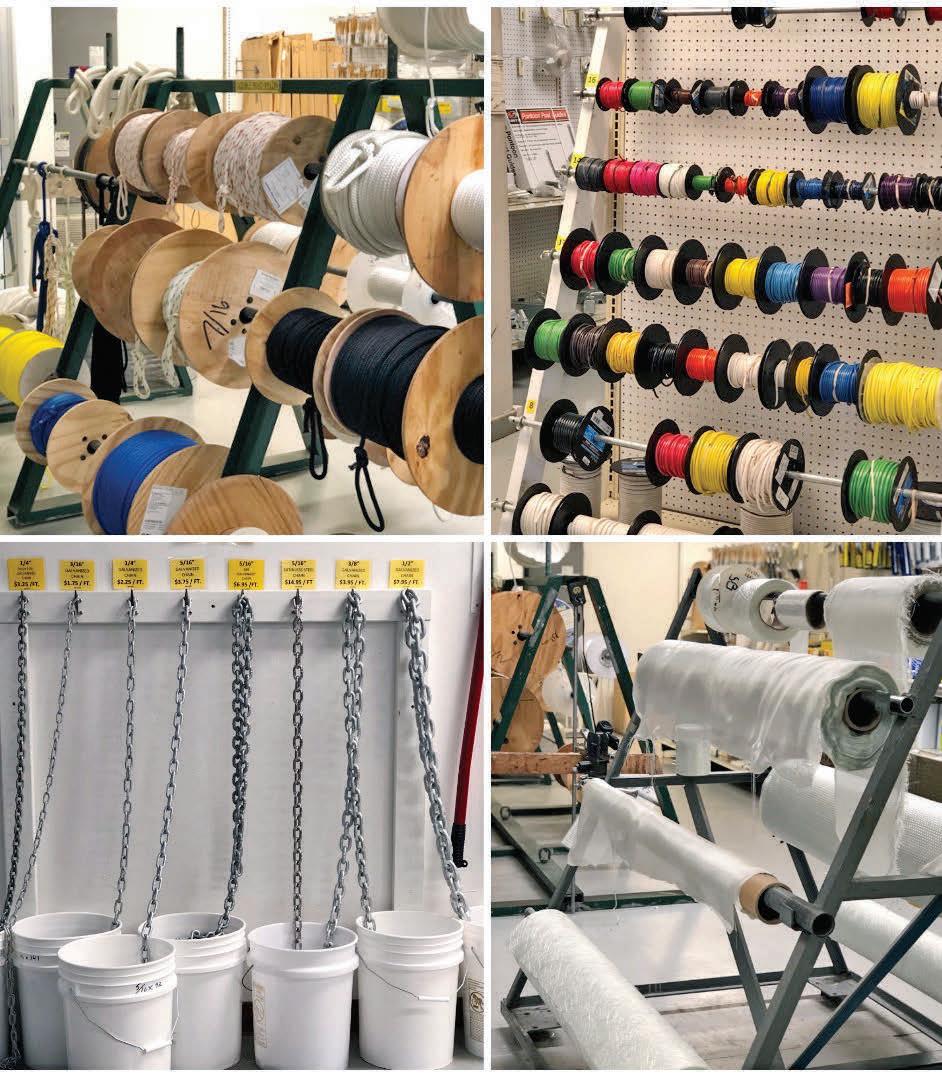
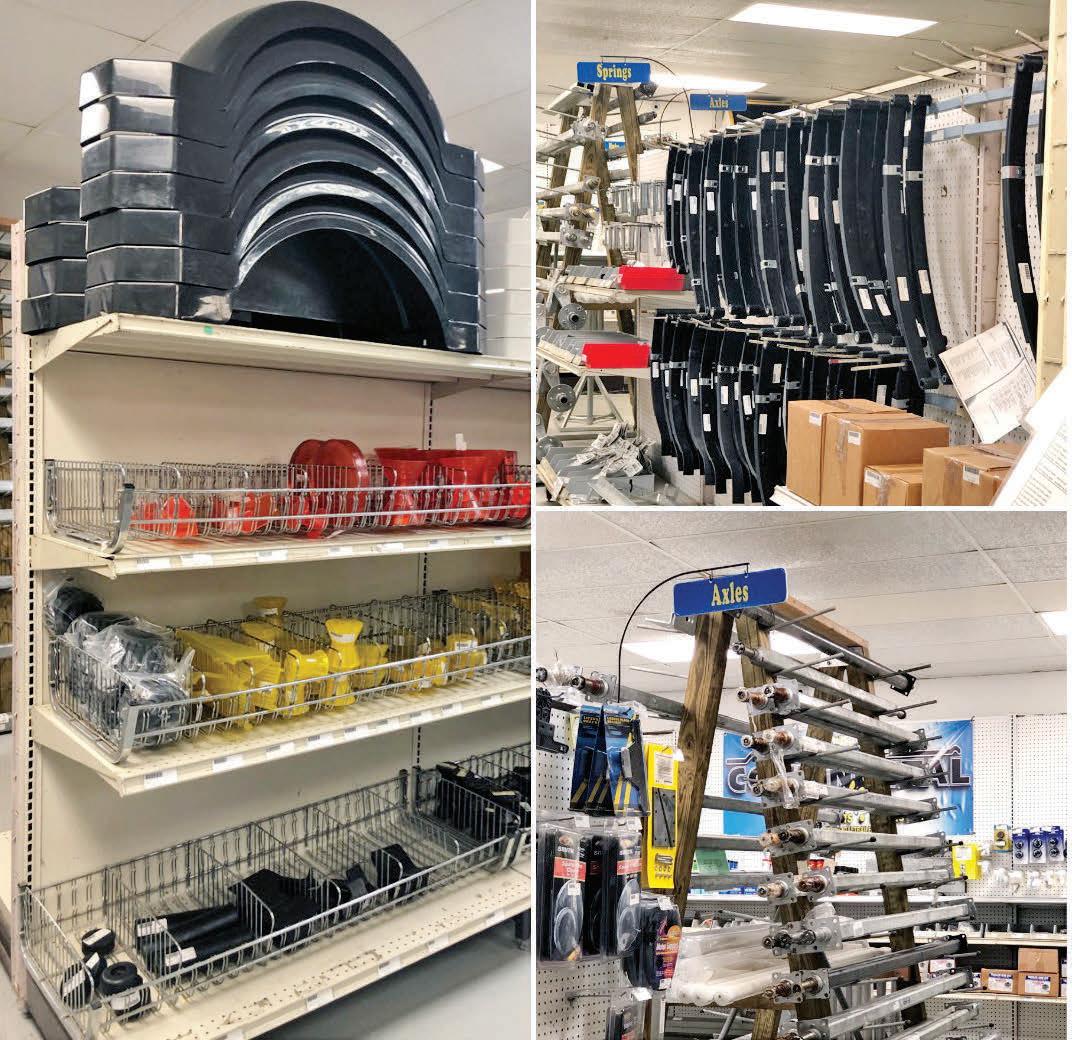























By Will Schmidt
Sail!sh are known as the fastest !sh on the planet, but they o er more than blazing speed to those who chase them o Florida’s east coast, such as I did on a recent !shing excursion. Spectacular surface bites and astonishing acrobatics make these !sh a coveted catch for even the most experienced anglers. For !rst timers, it’s an adrenaline !led !ght that will stick with you long a er the !sh swims back into the cobalt blue Atlantic. is trip was special for a few reasons. First, we had rising country star Ben Gallaher (IG: @Ben_Gallaher) with us. Ben is an avid outdoorsman and bass !sherman, but he had never caught a saltwater !sh. I was also excited to !sh with some new friends, Capt. Geoge Gozdz of “Unfathomed” (IG: @captgeorgegozdz) and Chris Bishop, VP of marketing at Yo-Zuri (iG: @Yozuri_Lures).
A er just a short run o Port St Lucie, we set our spread, and I could sense any strikes would likely be dramatic. e water was crystal clear and glass at giving us a great view of any action. e !rst !sh in, came crashing into the spread chasing and slashing at a bait with its bill. Unfortunately, as aggressively as it came in, it turned and retreated without eating.
As we reset the spread anticipation grew to !nd Ben’s !rst saltwater adversary. Fortunately, another sail came in a smashed the right rigger. However, it ran right at us, and we were never able to get tight. Undaunted, we set up again. Soon all the baits were nervously darting on the surface. e le atline erupted as the sail slashed, splashed and devoured the bait. Ben was on, and this !sh leapt and twirled with all the acrobatics of a Cirque du Soleil show. ere was still another to eat and moments later we doubled up. Both !sh cooperated with plenty of arial antics and a er a good !ght we had both !sh to the boat. To say Ben was pumped to land his !rst bill!sh is an understatement. Amped up with adrenaline and ready for more he could only beam with an ear-to-ear grin and say “let’s go!”

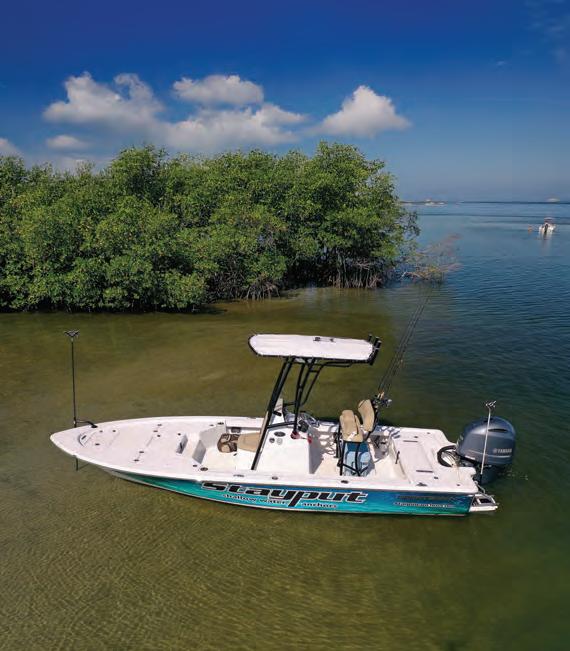










Fall !shing o of Port St Lucie o ers warm water and a hot bite without having to battle high winds and cold temperatures o en associated with winter sail!sh !shing in Florida.. Moreover, it’s not di&cult at all. We were simply bump trolling large, bridled thread!ns. Bridling helps the bait last longer and doesn’t allow for the hook to turn into the thread!n causing a missed strike. Our tackle was medium Penn Carnage rods with Authority reels lined with Yo-Zuri Super Braid topped with Yo-Zuri’s Disappearing Pink Fluorocarbon leader. ese setups gave us the sensitivity to feel the “eat” and the stealthiness to fool even the most cautious of !sh in these clear conditions. On your next trip don’t rush past these exciting sails, stop for some fun acrobatic action.
Will Schmidt is a seasoned tournament angler who has been writing about shing for more than two decades. Follow Will on Instagram @saltynstrong.

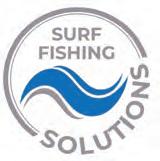

It’s no fsh tale when you run with a John Deere. You can get everything done faster and easier, so you get more time on the water. Plus, our special offers make them the catch of the day.




Anglers from around the world come to the U.S. Virgin Islands to !sh our incredible turquoise waters for trophy blue marlin, black!n tuna, wahoo and mahi-mahi. And with no passport required for U.S. citizens, it’s easy to plan your next !shing trip. Whether you want to set o on a crewed charter complete with a professional captain or prefer to simply cast a line from one of our scenic white-sand beaches, get ready to reel in the big one. Plus, many out!tters can customize your trip to include thrilling underwater activities like snorkeling.
O the island of St. Croix choose your own adventure, whether you’re looking to !sh o shore for mahi-mahi, wahoo, king!sh, tuna and blue marlin, or nearshore for tarpon, snapper, mackerel, rainbow runner and jacks. Seasoned crews who have been !shing the waters of USVI for decades will take you on customizable charters in search of catching your trophy !sh of a lifetime. Some out!tters o er complimentary !sh cleaning services, so all you have to do is throw your coveted catch on the grill or in the pan!
From St. John, troll for big game !sh—blue marlin, sail!sh, tuna, mahi-mahi and wahoo—on an o shore charter. Opt for a nearshore charter to catch bonito, barracuda, rainbow runner, snapper and
sharks. Or join an inshore bottom !shing trip to cruise the USVI’s deep-water reefs. Whether you’re an experienced angler or a novice needing some guidance, you’ll !nd an out!tter equipped with all the top-of-the-line !shing gear you’ll need for a successful day at sea.
About 20 miles north of St. omas is the North Drop, an area unparalleled for its big game !sh. Book a deep-sea !shing charter and sail over to this corner of the Caribbean that boasts more blue marlin bites per boat than any other place in the world. Half-day to 10-hour o shore bait !shing charters are ideal for adventurous anglers eager to experience the island’s famous North and South Drops. A mix of trolling and live baiting makes for mega catches, with yellow!n tuna, wahoo, mahi-mahi and blue marlin the most common catches of the day.

Surrounded by pristine blue waters, it’s no surprise that fresh seafood is a delicious part of nature’s bounty in USVI. You’ll !nd plenty of seafood-focused restaurants, from elegant !ne dining to laid-back waterfront eateries. Some out!tters even o er a stop at a seaside restaurant as part of their !shing excursions.







When the leaves start to turn and the water temps dip, bass anglers know what time it is—the fall feed. Bass are chasing bait like crazy, and it’s one of the best times of year to put big !sh in the boat. e trick is knowing what to throw as the season shi s. Here are !ve proven fall baits that will help you stay on the bite no matter what the lake throws at you.
Spinnerbait: Few baits scream “fall” like a spinnerbait. When the wind picks up and shad push shallow, it’s hard to beat a double willow blade ashing through the chop. e ash and thump imitate a school of eeing bait!sh, and hungry bass can’t resist. Target windy points, creek mouths, and shallow ats anywhere the bait’s getting pushed around.
Lipless Crankbait: is one’s all about covering water. Fall bass are constantly on the move, and a lipless crank lets you !nd ’em fast. Burn it over grass, rip it free when it hangs up, and hold on! at reaction bite is what fall !shing’s all about. Red or chrome patterns are money this time of year, especially when bass are chasing shad.
Jerkbait: Once the water clears and the temps drop into the 60s, it’s jerkbait season. Work it with a twitch-twitch-pause cadence, and you’ll mimic dying bait!sh to perfection. is lure shines around suspended bass that hang
o points or creek channels.
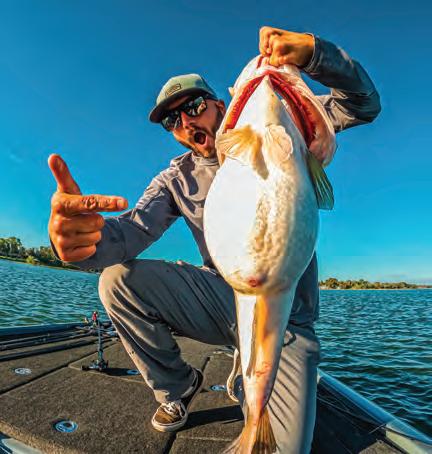

RJust be patient. Sometimes the bite comes right when you least expect it, on that long pause. Squarebill Crankbait & Swimbait: To round out your fall lineup, keep a squarebill and a swimbait on deck. A squarebill is your go-to for shallow cover stumps, rocks, laydowns, anywhere bass are ambushing bait in the backs of creeks. Meanwhile, a so or hard-bodied swimbait is ideal when you’re around big !sh feeding on larger forage. Slow-roll it through bait schools or along creek channels for some of the biggest bass of the year.
Fall is all about !nding the bait, and these !ve lures all mimic shad in their own way. Whether you’re slow-rolling a spinnerbait through wind-blown banks or ripping a lipless crank across a at, the !sh are feeding and it’s your job to get in on the action. Grab a few of these baits, follow the shad, and enjoy one of bass !shing’s most exciting seasons!
Tyler Woolcott is a professional tournament angler and guide. Check out his website at www.tylerwoolcott shing.com.

ed!sh are one of the most sought a er game !sh by inshore !shermen from Texas to the Carolinas. ey are great !ghters; they are great tasting; and they are perfect for sight !shing because they love super shallow water. Red!sh are part of the drum family and have four nostrils. is tells us that scent is their chosen sense while searching for food in dark and murky water.

e best red!sh lure that I have ever used is the 3-inch Berkeley Gulp! Shrimp. Berkeley Gulp! products are the smelliest baits that I have ever smelled and red!sh love them. ere are probably other stinky baits that work, but I haven’t found one that is comparable to Gulp! products. e best colors are anything with brown and gold glitter. Rootbeer and new penny are the best choices. e second best lure for catching red!sh is the gold or copper weedless spoon. ese are great search baits when you cannot see the red!sh. A slow retrieve with almost constant contact with the bottom is the way to !sh these lures. ese lures are exceptional for casting. ey cast a mile and let you cover a lot of water as you search for the schools of red!sh in the shallows.
e third best lure for red!sh are 3- and 4-inch paddletails rigged weedless. is is another great search bait for covering large areas of water. You will want to retrieve your paddletail in a similar way to your spoons. Make sure to bounce it o the bottom as you slowly retrieve it.
Contact Capt. Mike Smith, owner of Fish Your Ass O Charters, at (561) 339-2317, contact@ shyourasso .com or shyourasso .com.








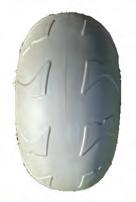

“I never expected it to be so beautiful that it takes your breath away.”
— Kaya C., on Stauer Opals
In a quaint village, nestled between rolling hills, lived a young woman with a deep appreciation for gemstones. Her grandmother gifted her a delicate cross pendant adorned with opals. "e opals shimmered with a mesmerizing play of colors, reflecting hues of blues, greens, and fiery oranges. Her grandmother shared the legend of the opals, believed to bring hope, purity, and luck to those who wore them.
Using this story as inspiration, Stauer brings you the Opal Spirit Cross Pendant. With over 2 total carats of Kyocera lab-created opals set in .925 sterling silver encased in yellow gold, this pendant is a radiant celebration of beauty and craftsmanship. Each opal captivates with a kaleidoscopic dance of fiery oranges blending into oceanic blues, streaked with flashes of vibrant green that seem to come alive with every movement. "e shimmering opals are skillfully arranged to create an enchanting, otherworldly glow, embodying the spirit of hope and harmony. "is breathtaking combination of color and craftsmanship is available as a limited availability of only 930 pieces, making it a rare and treasured addition

to your jewelry collection. Plus, when you order today, you’ll receive the Opal Spirit Cross Pendant at an impossible price of just $59 normally $149!
Don’t miss your chance to own this exclusive tribute to timeless elegance and meaningful symbolism.
Jewelry Speci!cations:
• Pendant: 2 ½ ctw. Kyocera lab opals and DiamondAura® accents. Yellow gold-finished .925 sterling silver setting
• Chain: 18" gold-clad .925 sterling silver chain
Opal Spirit Cross Collection

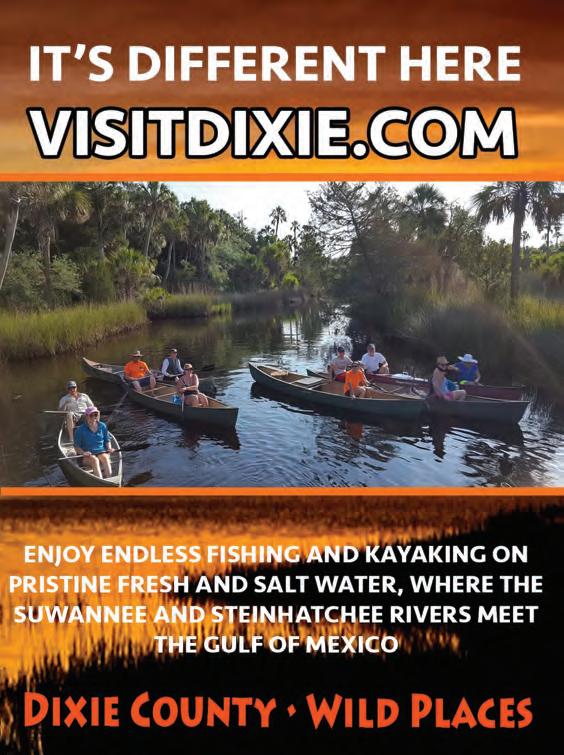


ovember is almost a completely unique month of the year. We’ll start getting the !rst real cold fronts, and this will pile the bait on temp breaks. Structure on the bottom will certainly hold the grouper and snapper on the bottom, but pay attention to the recorder and the marks in the mid water column. ese marks can be a number of the targets we’re looking for. Black!n are a given during the month of November, but it’s “go time” for wahoo and yellow!n. e bait can stand colder water than the pelagics. is is one of their biggest defensive strategies, and why you should have a (realistic) jig ready that can !sh 75-150 feet deep around the bait balls because the surface water will likely be as much as a few degrees warmer that the surface water due to the cold wind blowing overhead. Keep live baits out on circle hooks and ourocarbon and try to get some lower in the water column. ese live baits are black!n bombs ready to go o , but I am always drawn to the bottom in search for the grouper and snapper. Some of these same live baits or frozen cigs and sardines on the correct jigs (hint, hint) are irresistible to the !sh I’m really looking for. I want the big grouper and snapper bite. When you !sh the correct baits using the correct presentation, you’re not asking them to eat it, you’re MAKING them eat it! BAM! is is also African pompano candy. e jig in the mid to lower part of the water column is deadly, but if there’s no bites !shing it deeper and deeper all the way to the bottom, bring it up to the surface and repeat the process.

A trolling motor will really help in this controlled dri , keeping the bow forward into the wind and/or current. is will keep the light line out back and the baits on or near the bottom slightly back depending on the current. is is the bottom line: bag the trolling crap, post up on stacks of bait with dedicated crew for the light line and/or jig and dedicated crew on the bottom to generate groceries in the cooler. is is my kind grocery shopping.
Learn the drill of how to !sh the entire water column nice and quiet with beautiful baits and tactics for results. Dress with proper !tting foul weather gear and take plenty of photos and videos you can enjoy for years to come.
Learn more from Tim Barefoot on his YouTube channel and at barefootcatsandtackle.com.
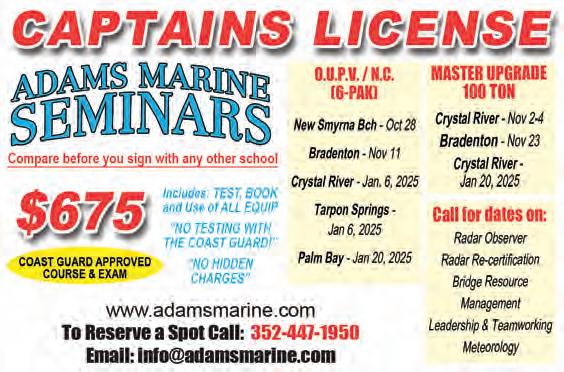
Spot Call: 352-447-1950









It was a warm summer afternoon and my wife and I were mingling with the best of them. The occasion was a 1920s-themed party, and everyone was dressed to the nines. Parked on the manse’s circular driveway was a beautiful classic convertible. It was here that I got the idea for our new 1920s Retrograde Watch.
Never ones to miss an opportunity, we carefully steadied our glasses of bubbly and climbed into the car’s long front seat. Among the many opulent features on display was a series of dashboard dials that accentuated the car’s lavish aura. One of those dials inspired our 1920s Retrograde Watch, a genuinely unique timepiece that marries timeless style with modern technology.

With its remarkable retrograde hour and minute indicators, sunburst guilloche face and precision movement, this design is truly one of a kind. What does retrograde mean? Instead of displaying the hands rotating on an axis like most watches, the hands sweep in a semicircle, then return to their starting point and begin all over again.

Retrograde watches by the big brands can set you back thousands; one recent offering from a big French fashion house is selling for more than $150,000! But because we’ve designed the 1920s Retrograde Watch in-house, we can offer it to you for just $99!
This watch is so wildly popular with our customers that we’re actually concerned about running out; we only have 937 729 left for this ad!
Join more than 1 MILLION smart people who love stauer watches

Watch Specifications:
• Precision movement
• Stainless steel case, caseback and crown
• Retrograde hour and minute indicators
• Water-resistant to 5 ATM




• Brown genuine leather band
• Fits wrists up to 8"
1920s Retrograde Watch
$399 $99* + S&P Save $300


*Special price only for customers using the offer code.





“An elegant and exciting timepiece that every collector will love.”
— George Tomas, internationally renowned watch expert



“[A] unique and beautiful timepiece.”
— Carlos C., Los Banos, CA




